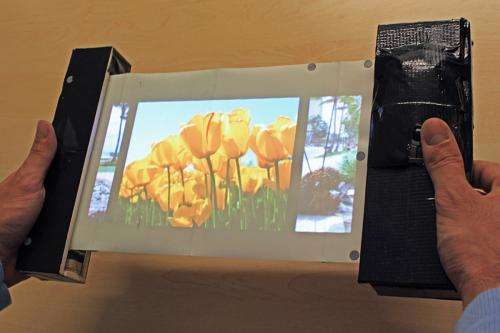The mobile telephones of the future

The mobile telephones of the future will be able to see, shrink while becoming larger, and slip into their users' skins. That terse statement summarizes the recently released results of a thorough look at the next ten to fifteen years of mobile telephony by the Technische Universität Darmstadt's "Future Internet" research cluster.
The cluster's researchers generated a research roadmap incorporating visions of the future and defined the necessary technological prerequisites. The outcome was a set of research areas that need to be addressed, and members of the Darmstadt team are already bubbling over with ideas regarding how to attack them, as Professor Dr. Max Mühlhäuser, head of the roadmap project, commented.
The displays of future mobile telephones will merge virtual and physical reality. They will enrich images that their cameras capture with other information. For example, if their camera is pointed at Berlin's Reichtag, they will overlay its image with a 3-D view of that building, as it appeared back in the 1920s. Mühlhäuser noted that, "The challenge there will be that both selected buildings and everyday scenes will have to be recognized."
The mobile telephones of the future will need large displays, but be capable of being shrunk to the size of a pencil. Although displays that can be rolled up and folded will take care of that, Mühlhäuser added that, "Users will have their hands full simultaneously manipulating the display and the telephone's controls." Members of the Darmstadt team already have ideas regarding how the motions of rolling and folding displays can be translated into telephone operating instructions, such as zooming in on a section of a map.
"The user needs a device which he can trust"
Future mobile-telephone networks will have to be capable of handling much higher transmission rates than their current counterparts. Mobile telephones and their networks will have to be more flexible in dealing with variations in signal levels. Mobile telephones will have to return responses from the "cloud" on a millisecond time scale, where a portion of the "cloud" will have to shift to mobile-telephone users' immediate vicinities. Mühlhäuser calls those mobile portions of the "cloud" "cloudlets."

The Darmstadt roadmap also envisions how future mobile telephones will become the heart of new security concepts. Since mobile telephones are handling growing numbers of critical smart-phone services, such as opening doors or handling payment of tolls, legal and financial risks will be involved. Mühlhäuser emphasized that, "Users will need a telephone that they can trust if it is to represent their interests on the network on its own."
Mühlhäuser pointed out that one of the key problems involved there is that, "The security infrastructure is currently housed in insecure mobile telephones." Only an encapsulated nanocomputer that is not under the thumb of commercial interests can become users' "second skin." Such tiny delegates to the virtual world could be incorporated into, e.g., users' finger rings, and would manage their passwords and payment accounts or control exchanges of their personal data with the environment.
Provided by Technische Universitat Darmstadt




















